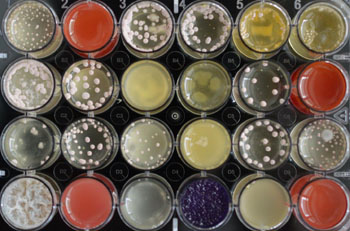Fungi Exposed to Valproic Acid Produce Substances with Potential Antibiotic Properties
By LabMedica International staff writers
Posted on 27 Jul 2016
Drug developers have used valproic acid (VPA) to coax various types of fungi to produce "cryptic" bioactive molecules, some of which have potential as antibiotic agents.Posted on 27 Jul 2016
Valproic acid is used primarily to treat epilepsy and bipolar disorder. It is also used to prevent migraine headaches. An entirely different application is its use to induce fungi to produce bioactive compounds.

Image: Fungi can be stimulated with distinct substances for production of antibiotic metabolic products (Photo courtesy of BiMM Research).
In recent years there has been increased interest in fungi as sources of antimicrobial compounds due to their ability to produce a large variety of bioactive compounds and the observation that virtually every fungus may still contain yet unknown so called “cryptic,” often silenced, compounds. These speculated metabolites could include novel bioactive compounds such as antibiotics.
Investigators at the University of Veterinary Medicine (Vienna, Austria) reported in the April 13, 2016, online edition of the journal Frontiers in Microbiology that the supernatant of the fungus Doratomyces microsporus treated with VPA displayed antimicrobial activity against Staphylococcus aureus and two methicillin resistant clinical S. aureus isolates.
VPA treatment resulted in enhanced production of seven antimicrobial compounds: cyclo-(L-proline-L-methionine) (cPM), p-hydroxybenzaldehyde, cyclo-(phenylalanine-proline) (cFP), indole-3-carboxylic acid, phenylacetic acid (PAA) and indole-3-acetic acid. The production of the antimicrobial compound phenyllactic acid was exclusively detectable after VPA treatment. Furthermore, three compounds, cPM, cFP, and PAA, were able to boost the antimicrobial activity of other antimicrobial compounds.
The compound cPM, which was isolated from fungi for the first time, was able to decrease the minimal inhibitory concentration of ampicillin in MRSA strains.
"Fungi can even deactivate the respective parts of their genome if a metabolite is not needed anymore. These compounds cannot be detected any longer and are classified as cryptic compounds," said first author Dr. Christoph Zutz, a researcher at the University of Veterinary Medicine. "Unlike industrial enterprises, we investigate all promising metabolites in microorganisms, not only single chemical compounds. Thus, we consider known and cryptic compounds in our analyses."
The study was conducted in conjunction with the new "Bioactive Microbial Metabolites" research platform or BiMM (Tulln, Austria).
"Valproic acid is not the only way to gain active compounds from fungi or other microorganisms. You can also make bacteria and fungi grow together. This also leads to a natural stimulus," said Dr. Joseph Strauss, head of BiMM.
Related Links:
University of Veterinary Medicine
BiMM













